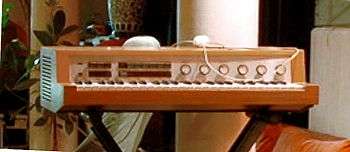Philicorda

The Philicorda was an electronic organ, produced in the 1960s by Philips. It was Philips' first entry into musical instruments and targeted the home market.
History
The Philicorda came out of the Philips Natuurkundig Laboratorium in Eindhoven, under Tom Dissevelt und Dick Raaijmakers, who worked on electronic music and electronic musical instruments; it was here that the prototype of the AG7400 organ was produced.
1960s Models
The AG7400 was launched onto the market in 1961, as a four-octave, 49 keys single manual, beginning with tone C version. Unusually for the time, it offered several audio inputs and outputs. The organ also shipped with a volume pedal and offered three settings--organ, organ with bass keys and single-finger chords. The AG7400 did not have an internal speaker.
At the beginning of 1963, its successor, the AG7500, was officially launched as the Philicorda. As well as the AG 7500/00, various other versions were produced amongst others for the English (AG7500/11?) and German (AG7500/22) markets. Located below the AG7500 was a tube amplifier with speakers.
The AG7600, launched soon after, was a soundbar type separate amplifier with loudspeakers and offered a spring reverb effect.
The Philicorda 751 (22GM751 with various country specific suffixes such as 22GM751/22 for Germany) was launched in 1967, some of them had both valves (preamp stage) and transistors, followed by the 22GM752, which was fully transistorized. A later model, the 22GM753, launched at the end of 1967, was designed for the stage and was fully transistorized.
Although Philicordas, from the AG7400 to the 22GM753, had slight differences in sound, the Philicorda's typical warm tone, produced using cold cathode tube oscillators, was consistent over the years.
Single-Finger Chords
Each Philicorda had 17 pre-programmed chords (C - A7 - Dm - Eb - Em - F - D - G - E7 - Am - B - G7 - Cm - B9 - Gm - F7 - C7), although key assignments varied between models.
Licensing
In the USA, the Philicorda 753 was distributed by J. C. Penney under the Penncrest name, available in blue or black, as opposed to the previous natural wood finishes.
1970s Models
The GM754 was launched in the early 70s, with altered chord availability, speaker holes below the chassis and sliders instead of knobs.
The GM760 series were double-manual organs. In the late 70s, Philips launched the double-manual PhilicordaRhythm series.
In pop music
In the 1960s, the Philicorda was utilized by bands including The Monks.
In recent years, the organ has undergone a revival. Notable users include Nick Power of The Coral and Teenage Fanclub's Norman Blake. The Philicorda also features on 19 by Adele.
